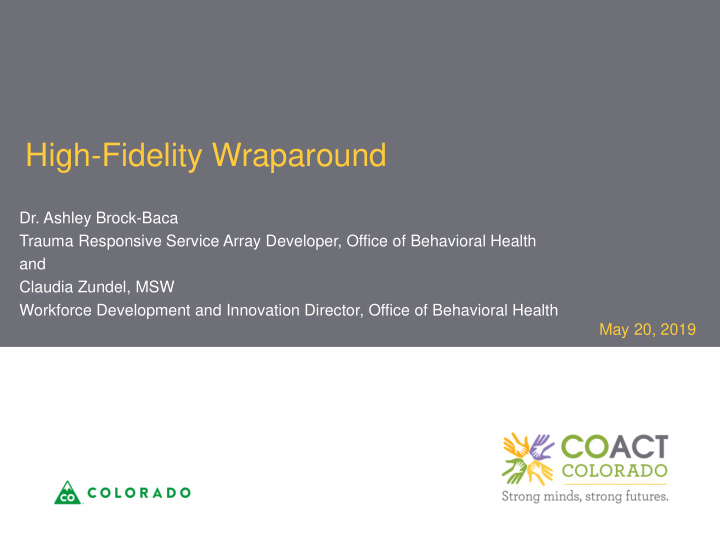



High-Fidelity Wraparound Dr. Ashley Brock-Baca Trauma Responsive Service Array Developer, Office of Behavioral Health and Claudia Zundel, MSW Workforce Development and Innovation Director, Office of Behavioral Health May 20, 2019
Agenda Wraparound Overview − Principles − Theory of Change − Phases − Roles − What’s different about HFW Credentialing 2
What is Wraparound? https://vimeo.com/38060393 Wraparound is an evidence-based team process to manage care for families with complex needs who are involved in multiple systems Designed for the most complex families in order to reduce out-of-home placement and youth homelessness Develops an integrated plan that utilizes individual strengths, needs, and culture Family driven process that uses natural and informal supports Makes case work easier and more efficient for providers 3
10 Principles of High Fidelity Wraparound Family voice and choice Team-based Natural supports Collaboration Community-based Culturally competent Individualized Strengths-based Persistence Outcome-based (Source: National Wraparound Initiative) 4
Wraparound’s Theory of Change Self-efficacy Youth/Family Natural prioritized supports needs Positive Integrated Purposeful planning Outcomes transition 5/23/2019 5
Phases of Wraparound Engagement Planning Implementation Transition Plan for Orient the family Implement the Develop a plan completion of to wraparound plan wraparound Develop a Revisit and Stabilize crisis detailed crisis Conduct update the plan commencement plan celebration Maintain team Develop cohesion and Discovery trust Follow up with family Support Prepare for first purposeful meeting transition Engage potential team members
Wraparound Roles Wraparound facilitator or care coordinator : sets up meetings, oversees the plan, makes sure all of the team is participating, monitors progress Family advocate or family support partner : provides peer support to parents and caregivers, helps families build natural/informal supports, helps families advocate for themselves Team members − Formal supports: providers who are paid to work with the family, such as the wraparound staff, clinicians, probation officers, caseworkers, etc. − Informal supports: community resources available to anyone, such as recreation centers, churches, etc. − Natural supports: family, extended family, friends, neighbors, etc. 7
What Wraparound is NOT Wraparound is NOT a substitute for services, such as mental health, substance abuse, or family therapy Wraparound is NOT a crisis response service (although the wraparound process involves creating and utilizing a crisis plan) 8
What is different about Wraparound? High-fidelity wraparound may seem similar to other team- based or collaborative processes, but it is different in several ways: 1) In the wraparound process, the family and youth vision is what drives the plan. − It’s not just about agencies deciding how to work together to coordinate the family’s services. 2) Emphasis is placed on natural and informal supports. 3) The goal is to have a single, unified plan for the family that everyone on the team works together to achieve: formal supports (agencies) as well as natural and informal supports. − Agency involvement, health, and education/employment needs should be incorporated into the family plan. 9
Goals for Credentialing the Wraparound Workforce Quality • All wraparound clients receive high-quality, individualized, trauma-responsive care coordination and support. Fidelity • Fidelity to the 10 principles, action steps, and theory of change is consistent for all clients in high fidelity wraparound. Opportunity • All wraparound workforce receive the support and professional development they need to excel. 10
Fidelity Improves Outcomes with Wraparound Higher fidelity to the wraparound principles and practice is associated with better outcomes in − Behavior − Functioning − Restrictiveness of living − Satisfaction Bruns, E. J., Suter, J. C., Force, M. M., & Burchard, J. D. (2005). Adherence to wraparound principles and association with outcomes. Journal of Child and Family 11 Studies, 14 , 521-534.
Fidelity Improves Outcomes with Wraparound Percent of Youth Showing Improvement on the CANS by Wraparound Fidelity Scores 90% 82% 80% 69% 65% 70% 55% 60% 50% 40% 30% 20% 10% 0% Not Wraparound Borderline (65- Adequate Fidelity High Fidelity (<65%) 75%) (75-85%) (>85%) Effland, V. S., Walton, B. A., & McIntyre, J. A. (2011). Connecting the dots: Stages of implementation, wraparound fidelity, and youth outcomes. Journal of Child and Family 12 Studies, 20 , 726-736.
Ongoing Coaching Supports Fidelity Wraparound Fidelity in a System of Care with Variable Workforce Development Over Time 100% 86% 90% 80% 73% 72% 70% 64% 60% 50% 40% 30% 20% 10% 0% Pre Training Training Only Training + "Gone to Scale" Coaching No Coaching Bruns, E. (2015). Wraparound is worth doing well: An evidence-based statement. In E. J. Bruns & J. S. Walker (Eds.), The Resource Guide to Wraparound . Portland, OR: 13 National Wraparound Initiative.
Coaching Structure Tier Tier 1 2 Able to coach and Able to coach and credential WF, FSP, credential WF, FSP, and YSP, plus Tier 1 and YSP coaches Minimum 2 years of experience as a Tier Must have 1 coach, application experience as WF to CSTI Advisory or supervisor Board, and other requirements TBD 14
Supervision Structure All Wraparound Facilitators will be required to be directly supervised by a credentialed Tier 1 Coach or a credentialed Wraparound Supervisor Option A Option B In-house Supervisor Supervisor OR Coach In-house or external Coach 15
Wraparound Facilitators Foundations trainings • System of Care, Introduction to High Fidelity Wraparound, evaluation Complementary trainings • Youth Mental Health First Aid, Trauma Responsive Care Coaching • Passing scores on wraparound tools for meetings, documents, and theory of change Advanced trainings • Motivational Interviewing Fidelity • 85% on Colorado Wraparound Fidelity Tool 16
Colorado Wraparound Fidelity Tool Developed by the wraparound workgroup as an adaptation to Vroon Vandenberg materials Measures fidelity to the 10 principles of wraparound, the action steps, and the wraparound theory of change 4 versions, each in English and Spanish: − Wraparound staff − Family − Youth − Team members 17
Infrastructure: Cross Systems Training Institute (CSTI) The CSTI oversees training, coaching, and credentialing the system of care workforce − Wraparound facilitators − Family support partners − Wraparound coaches Cross system training in core topics such as trauma responsive care (for all child- and youth-serving agencies and schools) State/university partnership with Partners for Children’s Mental Health Contact: Ashley.Brock-Baca@state.co.us; coloradocsti.org 18
Recommend
More recommend